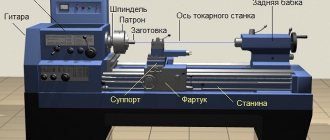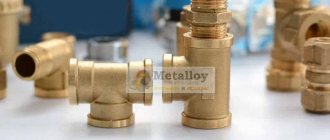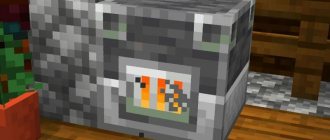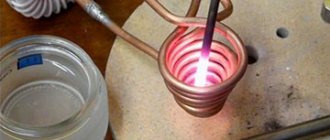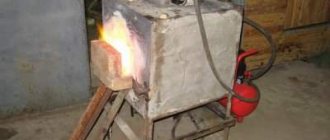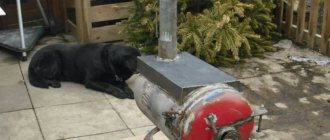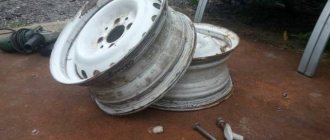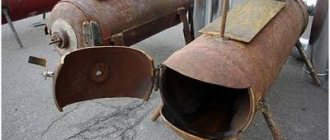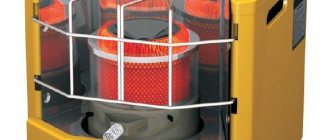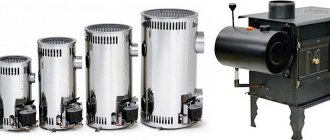The blast furnace smelting process is continuous. Source materials (sinter, pellets, coke) are loaded into the furnace from above, and heated air and gaseous, liquid or pulverized fuel are supplied to the lower part. Gases obtained from fuel combustion pass through the charge column and give it their thermal energy. The descending charge is heated, reduced, and then melted. Most of the coke is burned in the lower half of the furnace, providing a source of heat, and part of the coke is spent on reducing and carburizing the iron.
A blast furnace is a powerful and highly productive unit that consumes a huge amount of materials. A modern blast furnace consumes about 20,000 tons of charge per day and produces about 12,000 tons of pig iron every day.
To ensure the continuous supply and release of such large quantities of materials, it is necessary that the furnace design be simple and reliable in operation over a long period of time. The outside of the blast furnace is enclosed in a metal casing welded from steel sheets 25–40 mm thick. On the inside of the casing there is a refractory lining, cooled in the lower part of the furnace using special refrigerators - metal boxes inside which water circulates. Due to the fact that a large amount of water is required to cool the furnace, some furnaces use evaporative cooling, the essence of which is that several times less water is supplied to the refrigerators than with the usual method. The water heats up to a boil and evaporates rapidly, absorbing a large amount of heat.
The internal outline of the vertical section of a blast furnace is called the furnace profile. The working space of the furnace includes:
- fire pit;
- mine;
- steam;
- shoulders;
- horn
Koloshnik
This is the upper part of the blast furnace, through which charge materials are loaded and blast furnace or top gas is removed. The main part of the blast furnace device is the filling apparatus. Most blast furnaces have double-cone charging devices. In the normal position, both cones are closed and reliably isolate the interior of the furnace from the atmosphere. After loading the charge into the receiving funnel, the small cone is lowered and the charge falls onto the large cone. The small cone closes. After the specified amount of charge has been collected on the large cone, the large cone is lowered with the small cone closed and the charge is poured into the furnace. After this, the large cone closes. Thus, the working space of the blast furnace is permanently sealed.
Charge materials are usually fed to the furnace throat from one side. As a result, a slope is formed in the funnel of a small cone. Long-term operation of a blast furnace with a skewed charge level is unacceptable. To eliminate this phenomenon, the receiving funnel and the small cone are made rotating. After loading the charge, the funnel together with the cone is rotated through an angle multiple of 60, due to which, after unloading several feeds, the unevenness is completely eliminated. 0
Modern furnaces can install charging devices that are more complex in design. Instead of a large cone, a rotating chute is installed, the angle of which can be adjusted. This design allows you to change the location of the material supply according to the diameter of the top.
During the blast furnace smelting process, a large amount of gas is formed, which is removed from the top part of the furnace. This type of gas is called top gas. The gas contains flammable components CO and H2 and, therefore, is used as a gaseous fuel in metallurgical production. In addition, passing through the charge column, the gas captures small particles of iron-containing materials, forming the so-called flue dust. Dust is collected in special gas purifiers and used as an additive to the charge during agglomeration or pellet production.
Blast furnace maintenance and repair
Any equipment that operates 24/7 requires constant maintenance. Regulations are included in the technical passport of the equipment. Failure to comply with the maintenance schedule will result in a reduction in service life.
Maintenance work on blast furnaces is divided into periodic and major repairs. Periodic work is carried out without stopping the work process.
Major repairs are divided into three categories based on the volume of work performed. During the first discharge, all equipment is inspected, and melts are removed from the shaft. During the second discharge, the lining is repaired and failed equipment elements are replaced. With the third category, the unit is completely replaced. Typically, such repairs are combined with modernization or reconstruction of the blast furnace.
Horn
This is the lower cylindrical part of the furnace where high-temperature blast furnace processes are carried out. In the furnace, coke is burned and blast furnace gas is formed, interaction between liquid phases, accumulation of liquid smelting products (pig iron and slag) and their periodic release from the furnace occur. The forge consists of an upper or tuyere part and a lower or metal receiver. The bottom of the metal receiver is called the flange .
At the bottom of the hearth there are cast iron and slag tapholes, which are holes for releasing cast iron and slag. After the cast iron is released, the tap hole is closed with a special refractory mass using a so-called gun, which is a cylinder with a piston. Before opening the cast iron tap hole, the gun is filled with tap hole refractory mass. After the end of cast iron production, the gun is brought to the tap hole, and with the help of a piston mechanism, the tap hole mass is squeezed out of the gun and fills the tap hole channel. To open a cast iron tap hole, a special drilling machine is used, which drills a hole in the tap hole mass through which the cast iron is released.
Slag tapholes are located at a height of 1500 - 2000 mm from the level of the cast iron taphole and are closed using a slag stopper, which is a steel rod with a tip. The cast iron and slag leaving the blast furnace are directed through chutes into cast iron and slag ladles. Currently, slag is mainly produced together with cast iron and is separated from the cast iron by a special device on the furnace chute.
The slag flowing from the blast furnace through the cast iron tap hole is separated from the cast iron on the furnace chute using a separating plate and pass, which act as a hydraulic seal. The high-density cast iron passes into the gap under the separating plate, while the lighter slag is discharged into a side chute.
If it is necessary to supply cast iron to other enterprises, it is poured into ingots (ingots) weighing 30–40 kg on a special casting machine.
In the upper part of the hearth, at a distance of 2700 - 3500 mm from the axis of the cast iron tap hole along the circumference of the hearth, air tuyeres are installed at equal intervals, through which blast heated to 1100 - 1300 ° C is fed into the furnace, as well as natural gas and other fuel additives (fuel oil, pulverized coal fuel). Each blast furnace is provided with blast from its own blower. Blast heating is carried out in regenerative-type air heaters, when, under the influence of the heat of the burned gas, the nozzle of the air heater made of refractory bricks is first heated, and then air is passed through it, taking heat from the nozzle. During the heating period of the nozzle, gas and air are supplied to the combustion chamber for its combustion. The combustion products, passing through the nozzle, heat it and go into the chimney. During the blast heating period, cold air enters the heated nozzle, is heated, and then fed into the blast furnace. As soon as the nozzle has cooled down so much that the air cannot be heated to the set temperature, it is transferred to the next air heater, and the cooled one is put on heating. The air heater nozzle cools faster than it heats up. Therefore, the block of blast furnace air heaters consists of 3–4 devices, of which one heats the air, and the rest are heated. The profile of a blast furnace is characterized by the diameters, heights and angles of inclination of individual elements. The dimensions of some ovens are shown in Table 1.
Table 1 - Furnace dimensions
| Dimensions, mm | Useful volume of the furnace, m3 | ||
| 2000 | 3000 | 5000 | |
| Diameter: | |||
| forge | 9750 | 11700 | 14900 |
| raspara | 10900 | 12900 | 16300 |
| fire pit | 7300 | 8200 | 11200 |
| Height: | |||
| full | 32350 | 34650 | 36900 |
| useful | 29200 | 32200 | 32200 |
| forge | 3600 | 3900 | 4500 |
| mines | 18200 | 20100 | 19500 |
The dimensions of each part of the furnace must be linked to each other and be in certain proportions with the sizes of other parts of the furnace. The furnace profile must be rational, which ensures the most important conditions for the blast furnace process:
- smooth and stable lowering of charge materials;
- favorable distribution of oncoming gas flow;
- favorable development of recovery processes and the formation of cast iron and slag.
The main quantities characterizing the dimensions of the working space are the usable volume of the oven and the usable height. They include the height and volume filled with materials and smelting products. When determining these parameters, the upper level is taken to be the mark of the lower edge of the large cone of the filling device in the lowered position, and the lower level is the level of the axis of the cast iron tap hole.
Story
The need to improve iron smelting technology arose a long time ago. Low-melting ores, located almost on the surface of the earth, did not have large volumes and were quickly consumed. The existing smelting technique was untenable and did not allow working with refractory ores. There was a need to improve existing equipment and technology. First of all, it was necessary to increase the size of the furnaces and significantly strengthen the pressurization mode.
The first mentions of structures similar to blast furnaces were found in China. They date back to the 4th century. In Europe, the appearance of blast furnaces dates back to the 15th century; before that, so-called cheese-blowing furnaces were used. The immediate predecessor of the blast furnace was the Catalan forge, which used technological techniques close to the blast furnace production method. Its distinctive features were:
- Continuous charge supply process;
- Use of powerful hydraulically driven air supply units.
14th century blast furnace
The volume of the Catalan forge was only 1 m³, which did not allow obtaining large volumes of products. In the 13th century, the Stutofen, an enlarged and improved version of the Catalan bugle, was created in the European principality of Styria. It was about 3.5 m in height and had two technological openings - the lower one for supplying air, the upper one for extracting kritsa (raw iron). Stukofen produced three types of semi-finished iron products:
- Steel;
- Malleable iron;
- Cast iron.
The difference between them was in the carbon content - most of it was in cast iron (more than 1.7%), in steel it was less than 1.7%, and in malleable iron the content was 0.04%. The high level of carbon content was assessed negatively, since cast iron cannot be forged, welded, and it is difficult to make weapons from it.
It is important! Initially, cast iron was classified as industrial waste because it could not be forged. Attitudes towards it changed only after the start of secondary smelting, which began to be done due to a shortage of fusible ores. Convertible iron obtained from cast iron was of higher quality, which served as an incentive to expand the conversion process.
Further expansion of capacity and improvement of technology gave rise to the emergence of the blaufen, which was already about 5–6 m high, capable of smelting cast iron and iron simultaneously. It was already practically a blast furnace, albeit a somewhat smaller, simplified design. A two-stage process was established, when the first stage was the production of cast iron, and the second was the smelting of iron from it under increased pressure.
The appearance of the first blast furnaces in Europe dates back to the end of the 15th century. Almost immediately, similar designs appeared in England, and in the USA the first blast furnaces were created much later - in 1619. The first blast furnace in Russia was built by A. A. Vinius at his manufactory in Tula. The process consisted of the following steps:
- Charcoal loading and pressurization.
- Placing pig iron in front of the mouth, melting, and draining the cast iron down.
- Loss of some carbon during passage near the tuyeres.
- Supply of the resulting iron to the nozzle, a powerful boost, during which the excess carbon burned out, and the soft iron settled at the bottom.
Iron was removed from the bottom of the forge and forged, removing liquid slag and compacting the pigs. With this method, the yield of finished iron was about 92% of the original weight of cast iron, and its quality significantly exceeded that of a critical product.
The fuel crisis became a serious problem. Charcoal was used to smelt the ore, which led to the destruction of forests. The problem grew to such an extent that metal was imported into England from Europe, and later from Russia, for 2 centuries. It turned out that the forest grows slower than it burns. Attempts to use coal have shown that it contains a large amount of sulfur, which significantly reduces the quality of the metal. Many experiments were carried out that were not successful.
This is interesting! The solution was found only in 1735 by the English metallurgist A. Derby II, who found a way to convert coal into coke. Since that time, the fuel problem was overcome, and the process received a new impetus for development.
The next revolutionary discovery was the heating of the air used for supercharging. It made it possible to significantly reduce coal consumption by up to 36%. There are special requirements for the grade and quality of metal in terms of manganese, silicon, and phosphorus content. The technology and design of furnaces were improved and supplemented, little by little coming to a modern look.
Fuel for blast furnace
A furnace for producing cast iron operates on raw materials such as coke, which occurs in special coke ovens where cast iron is smelted. Coke is produced from special coking coal. As a rule, at a large metallurgical plant, coke is produced in special coke-chemical workshops, where on average there are 50-70 furnaces or coking chambers. All of them are combined into one chamber.
The chamber is heated from outside. In order for the temperature inside the furnace cavity to remain at a level of 1000 °C, a temperature of 1400 °C must be maintained in the space between the chambers. The coke oven battery is heated by gas, which is mixed with heated air. During coking, as well as when coal is heated to a temperature of 100 °C, the slow evaporation of moisture begins, and then when the coal is heated to 350 °C, it is dried and the tars are removed.
When the temperature rises to 450 °C, the particles in coking coal begin to soften, and the particles obtained by this method begin to envelop the non-coking parts of the coal, which forms a continuous mass, and subsequently a single alloy. To make the correct and high-quality composition, full compliance with all stages is required. When the heat of the mass reaches 480-650 oC, the mass begins to release organic gaseous products of dry distillation of coal.
If you use the production correctly, you get up to 750 coke from 1 ton of coal, as well as 300 m3 of coke oven gas and almost 35 kg of coal tar. Including 12 kg of benzene and 3 kg of ammonia. Coal is an excellent heat source that is used in private homes for heating.
Topic 10. Obtaining metals.
Part I
1. Metals occur in nature: 1) only in native form Pt, Ag, Au 2) both in free form and in the form of compounds Cu, Hg 3) only in the form of compounds: the majority, as well as active M (minerals Zn, Pb, Na, Li, etc.)
Summarize these statements using a series of metal activities using curly brackets:
2. Minerals are various natural compounds that include M in a bound state. Fill out the table “Names and formulas of metal minerals.”
3. Ores are natural formations containing minerals in which M are found in quantities suitable for obtaining them themselves.
4. Metallurgy is the science of methods and processes for the production of metals from ores and other metal-containing products.
5. Fill out the table “Classification of general methods for obtaining metals.”
Part II
1. Separation of waste rock from ore is beneficiation.
2. Fill out the table “Reducing agents in pyrometallurgy.”
3. Complete the diagram:
This is an example of electrometallurgy.
4. The raw materials for the production of aluminum are: a) aluminosilicates b) bauxite, corundum c) aluminum oxide.
5. Draw and describe a scheme for the electrolytic production of aluminum. The process of producing aluminum by electrolysis is carried out in electrolytic baths in the presence of molten cryolite; made of aluminum oxide;
6. Write a syncwine about metallurgy. 1) Metals 2) Method of production 3) Pyro-, electro-, hydrometallurgy 4) Basis of industry 5) Production.
7. Draw and describe a diagram of the blast furnace process. The essence of the blast furnace process is the reduction of iron from oxides and the production of carburized metal (cast iron) and slag, which are easily separated from each other due to differences in densities.
The iron obtained as a result of the reaction flows down in drops over the hot coke, becoming saturated with carbon, resulting in an alloy containing 2.14 - 6.67% carbon (cast iron). In addition to carbon, it contains a small proportion of silicon and manganese. In tenths of a percent, cast iron also contains harmful impurities - sulfur and phosphorus. In addition to cast iron, slag is formed and accumulated in the furnace, in which all harmful impurities are collected.
Additional furnace elements
The operation of the oven requires the operation of auxiliary devices. Among them:
- air heaters; large tower-type elements are located next to the furnace; blast furnace gas enters them, which then burns; due to this, even hotter gas is formed, heating the air through a complex system; the latter - heated to a temperature of at least 1000 degrees - is used for smelting cast iron;
- blowers; compressed air is necessary for fuel combustion; air enters the furnace thanks to devices that generate a pressure of about 25 MPa;
- devices for lifting and filling the charge;
- gas purifiers for cleaning blast furnace gases;
- other auxiliary devices - for example, overhead cranes with which foundry yards are equipped.
Modern furnaces are equipped with automation systems. Computerization makes it possible to control and regulate the basic parameters associated with the functioning of the blast furnace. The level of raw material filling, gas pressure, blast temperature, etc. are under control.
Bad cast iron
At high melting temperatures, ore iron quickly gets rid of the oxygen atoms that oxidize it and combines with carbon atoms (from coal). In the stukofen, iron was enriched with carbon before slag (other impurities) had time to separate from it. The slag was smelted when not only a lump of kritsa (iron with a small carbon content) had already formed in the furnace, but also molten cast iron (iron over-enriched in carbon).
The high carbon content made cast iron brittle and impossible to forge or weld. What could be done with such metal? And when smelting refractory ores, a lot of cast iron was produced, and it was mixed with liquid slag. At first this mixture was thrown away, but in the 14th century. They began to extract beads - homogeneous pieces of cast iron - from the crushed slag and cast rough products from it.
Who invented it?
The modern blast furnace was invented by J.B. Neilson, who was the first to heat the air supplied to the blast furnace, which happened in 1829, and in 1857 E.A. Cowper introduced special regenerative air heaters into use.
This made it possible to significantly reduce coke consumption by more than a third and increase the efficiency of the furnace. Before this, the first blast furnaces were actually cheese-blowing furnaces, that is, unenriched and unheated air was blown into them.
The use of cowpers, that is, regenerative air heaters, made it possible not only to increase the efficiency of the blast furnace, but also to reduce or completely eliminate contamination, which was observed in case of technology violations. We can safely say that this invention made it possible to bring the process to perfection. Modern blast furnaces operate precisely on this principle, although their control today is automated and provides greater safety.
